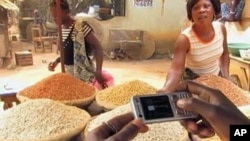Mobile phones are the latest weapon in the fight against hunger and poverty. The devices provide a new way to deliver information to developing world farmers in hard-to-reach places.
A group at the University of Illinois has produced several videos that demonstrate simple, low-cost ways to improve the lives of people in the developing world. One video shows farmers how to make a natural insecticide out of seeds from the neem tree.
Spreading the word
“There's been a dramatic revolution in the way that we can share information," says the University of Illinois’ Barry Pittendrigh. "And that's come about both through the Internet and through the dramatic increase in the use of cell phones, especially in developing nations.”
Cell - or mobile - phones are everywhere in the developing world and they are becoming increasingly sophisticated
“We discovered that many farmers had cell phones that would play video clips," says Purdue University crop scientist Jess Lowenberg-DeBoer. "We thought, ‘OK, can we use those cell phones as a way to communicate this visual information?’”
That visual information includes a video of how to close specially-designed storage bags so that they are airtight and protect crops from insect pests.
"Closing the bags is something that, if you see it, you will understand it very quickly, and most people do. But explaining it in words is quite difficult,” says Lowenberg-DeBoer, adding that one of the most remarkable things about mobile phone videos is how fast they can spread.
His team conducted an experiment where they loaded the video on seven phones and watched what happened.
“In one month, the video had spread to 118 people in 50 different villages," says Lowenberg-DeBoer. "And we think that this is just incredible impact from a very modest investment.”
Seeing is understanding
Farmers pass videos from phone to phone with Bluetooth wireless technology.
Those videos can be a real advantage when trying to reach farmers with little formal education, says Tolulope Agunbiade, with the University of Illinois.
“Getting the information across to them is a little difficult because some of them cannot read. But with the animations, it's easy to get the information across to them.”
The Illinois team can use the same computer animation in different regions by simply re-recording the narration in the local language. However, the Purdue team takes a different approach.
A Nod to 'Nollywood'
“We film them locally," says Lowenberg-DeBoer. "And when people see the local landscape, the way they build their houses, the way they build their granaries, they think, ‘Oh, this was made just for us.’”
He says the rough production values take their cue from Nigeria’s popular low-budget 'Nollywood' films.
“That’s what people in that audience are expecting and, culturally, is perhaps more appropriate.”
With either approach, the point of mobile phone videos is the same, says Illinois’ Tolulope Agunbiade.
“It will get the information into the hands of the people that really need it, which are the farmers."
It’s a high-tech way to pass on low-tech solutions.











